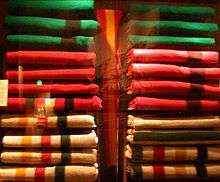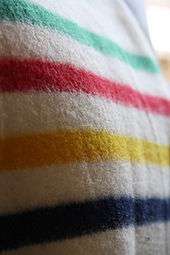Hudson's Bay point blanket

A Hudson's Bay point blanket is a type of wool blanket traded by the Hudson's Bay Company (HBC) in British North America (now Canada) and the United States during the 18th century and 19th century. The company is named for the saltwater bay in Northeastern Canada and the blankets were typically traded to First Nations in exchange for beaver pelts. The blankets continue to be sold by Canada's Hudson's Bay stores and have come to hold iconic status in Canada. In the United States they can be found at luxury department store and Hudson's Bay sister chain Lord & Taylor.
Importance to Native trade

In the North American fur trade, wool blankets were one of the main European items sought by native peoples in exchange for beaver pelts, buffalo robes, pemmican, moccasins, and other trade goods. They were desired because of wool's ability to hold heat even when wet, and because they were easier to sew than bison or deer skins.
Wool cloth of one kind or another was traded as far back as the French regime in North America (1534–1765), but HBC point blankets were introduced in 1780 to compete with similar blankets offered by the Montreal-based private traders.[1] The blankets were often produced with a green stripe, red stripe, yellow stripe and indigo stripe on a white background; the four stripe colours were popular and easily produced using good colourfast dyes at that time.[2]

From the early days of the fur trade, wool blankets were made into hooded coats called capotes by both natives and French Canadian voyageurs, which were perfectly suited to Canada's cold winters.[3]
"Point" value system
The short black lines woven into the blanket just above the bottom set of stripes are referred to as "points." About four inches in length (except in the case of half points, which are two inches), they indicate the finished overall size (area) of a blanket and allow a blanket's size to be easily determined while remaining folded. The "point" system was invented by French weavers in the mid-18th-century since then, as now, blankets were shrunk as part of the manufacturing process. The word point derives from the French empointer, meaning "to make threaded stitches on cloth." Although the company had been selling blankets since its founding in 1670, the first Hudson's Bay "pointed" blankets appeared in 1780.[4]
Over the centuries the sizes of blankets have shifted, particularly during the 20th century as beds became larger. Blankets of 2.5, 3, 3.5 and 4 point were most common during the fur trade era. Today Hudson's Bay blankets are commonly found in point sizes of 3.5 (twin), 4 (double), 6 (queen) and 8 (king).[4]
The misconception persists that originally the points were an indication of the blanket price in beaver pelts or even its weight. Thickness and quality are the same blanket to blanket, and a larger blanket will naturally weigh more.[4]
Current use
Made in England from 100% wool, versions of the blanket are available at Hudson's Bay stores throughout Canada. Solid colours are available, as is the classic pattern featuring the green, red, yellow, and indigo stripes. Newly made blankets retail at between Cdn $295 and $495. Today the blankets are made in England by John Atkinson, a sub brand of A.W. Hainsworth & Sons Ltd.[5]
The official licensee allowed to import Hudson's Bay Blankets into the United States for commercial sale is Woolrich Inc. of Pennsylvania. Four U.S. retailers currently sell the blankets to consumers: Woolrich, Lord & Taylor (sister chain to Hudson's Bay), L.L.Bean, and Marquette, Michigan department store Getz's.[6]
The coloured stripes appear on textile products by other manufacturers including some patterns on blankets made by Pendleton Woolen Mills[7] which makes a wool coat with the Hudson's Bay stripes sold at Hudson's Bay stores.[8] The "Hudson's Bay stripes" sometimes are also found on numerous additional items, such as scarves, beanies, coffee mugs, mittens, and the like.
Collectability
Many early point blankets have survived into the 21st century and have become collectors items. The Oregon-based sculptor Marie Watt (part Seneca) has used point blankets in her sculpture work, which was exhibited in 2004 at the National Museum of the American Indian in Washington, D.C..
Genuine point blankets have become very collectible and could fetch prices up to thousands of dollars. The main determinants of value include age, size, colour, pattern rarity and condition. Particularly collectible point blankets are the Coronation blankets: the one produced for the 1953 coronation of Queen Elizabeth II brings approximately $600 if in mint condition while examples of the even rarer 1937 Coronation blanket have sold for as high as $1300.
In 1890, HBC began adding labels to their blankets because point blankets of similar quality were being sold by HBC competitors from such manufacturers as Early's of Witney.[9]
Harold Lee Tichenor, point blanket collector and consultant to Hudson's Bay Company, has written two books on point blankets and their collectibility: The Blanket: an Illustrated History of the Hudson's Bay Point Blanket (HBC, 2002) and A Collector's Guide to Point Blankets (Cinetel, 2003).
Name in First Nations languages
The Hudson's Bay blanket was called by different names in First Nations languages. Some examples are:
- Baahlaads gyaa'adaay, Haida language[10]
- p̓a̱lx̱a̱lasǥa̱m, Kwak'wala[11]
- ʔa·q̓unaq, Kutenai language[12]
References
- ↑ "Parks Canada - Rocky Mountain House National Historic Site - Cultural Treasures". Pc.gc.ca. September 8, 2010. Retrieved October 19, 2013.
- ↑ Greenbaum, Hilary (September 19, 2011). "Who Made That Hudson's Bay Blanket?". The New York Times. Retrieved September 29, 2011.
- ↑ "the native canadian". Nativecanadian.ca. Retrieved October 19, 2013.
- 1 2 3 "Hudson's Bay Company: Our History". hbcheritage.ca. August 1, 2014. Retrieved August 1, 2014.
- ↑ "Interior Fabrics - Hainsworth Gems - About". Hainsworth. July 31, 2013. Retrieved October 19, 2013.
- ↑ "The Hudson's Bay Company Point Blanket: FAQs". Hbc.com. November 26, 2012. Retrieved January 11, 2016.
- ↑ "Pendleton Woolen Mills: GLACIER NATIONAL PARK BLANKET". Pendleton-usa.com. Retrieved October 19, 2013.
- ↑ "Our History: The Hudson's Bay Company Point Blanket: FAQs". Hudson's Bay Company. 2015. Retrieved 2015-10-28.
- ↑ "Witney Blanket Story". Web.archive.org. July 23, 2011. Archived from the original on July 23, 2011. Retrieved October 19, 2013.
- ↑ "FirstVoices: Hlg̱aagilda X̱aayda Kil words". Retrieved July 10, 2012.
- ↑ "FirstVoices: Kwak̓wala words". Retrieved July 10, 2012.
- ↑ "FirstVoices: Ktunaxa words". Retrieved July 10, 2012.
External links
| Wikimedia Commons has media related to Hudson's Bay point blanket. |
- Hbc Heritage - Our History - The Hbc Point Blanket
- The Witney Blanket Story - Archived comprehensive site about the Witney blanket industry, including manufacturers of Witney point blankets
- The Point Blanket Site - a basic introduction to the history of point blankets and information on dating and evaluation